Abstract
When the cholesterol saturation index of bile is reduced by wheat bran there is generally a fall in the deoxycholic acid content of bile. As the same effects occur with senna, bran might act on bile simply via its accelerating effect on colonic transit. We have studied the effects of a new, concentrated, wheat fibre preparation (Testa Triticum Tricum, Trifyba, which is 80% dietary fibre) upon bile composition, deoxycholic acid metabolism and intestinal transit time, and have assessed whether these effects are related. Twenty constipated volunteers were prescribed Testa Triticum Tricum in doses (10-32 g/day) sufficient to relieve their symptoms for at least six weeks. Before and at the end of this period, duodenal bile was sampled to enable measurement of deoxycholic acid pool (by isotope dilution), total bile acid pool, bile acid composition and cholesterol saturation index. Whole gut transit time fell from 120 +/- SD35 to 68 +/- 35 hours. At the same time, biliary % deoxycholic acid fell from 26.6 +/- 12.0 to 23.0 +/- 11.8 (p = 0.002), the total bile acid pool expanded from 2.36 +/- 0.88 to 2.75 +/- 0.90 g (p = 0.008) and cholesterol saturation index fell from 1.13 +/- 0.32 to 1.07 +/- 0.29 (p = 0.04). In subjects with initial cholesterol saturation index over 1.0 (n = 12), it fell from 1.33 +/- 0.25 to 1.22 +/- 0.21 (p = 0.008). There was no significant correlation between change in saturation index and change in % deoxycholic acid or deoxycholic acid pool, nor between any of these parameters and change in transit time. Testa Triticum Tricum reduces the cholesterol saturation index of supersaturated bile but this action appears to be independent of its effect on colonic transit and of changes in deoxycholic acid metabolism.
Full text
PDF
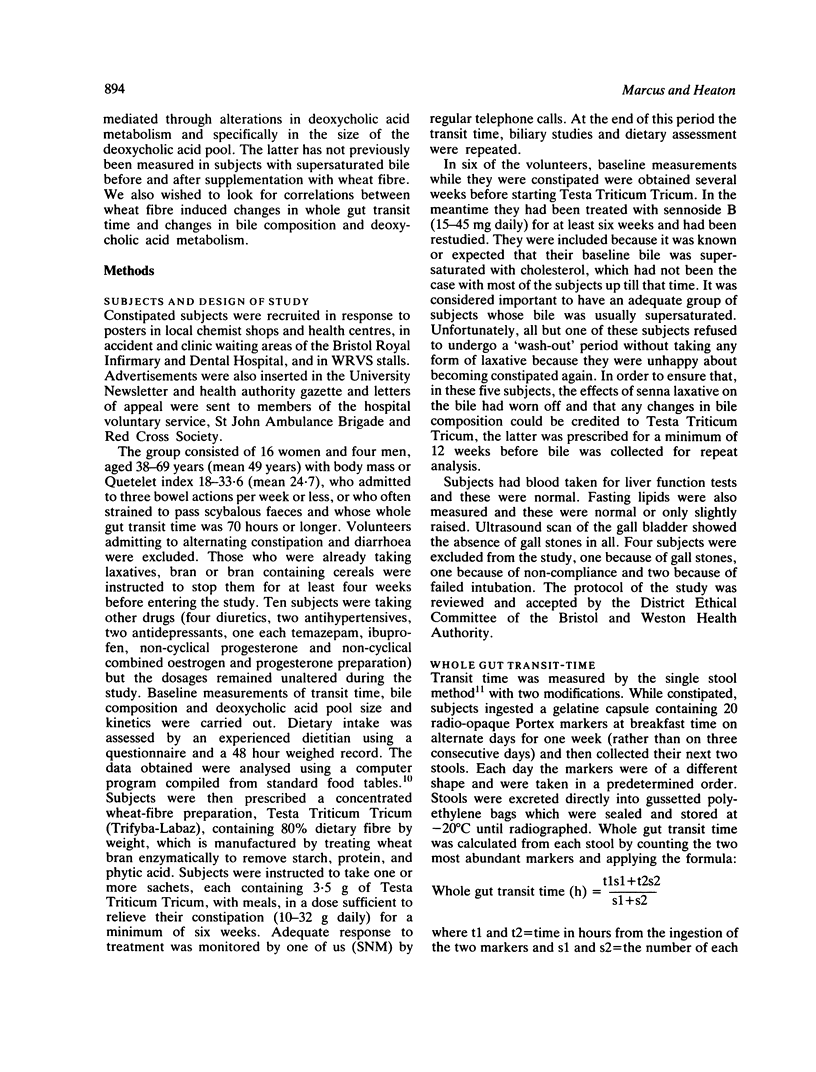


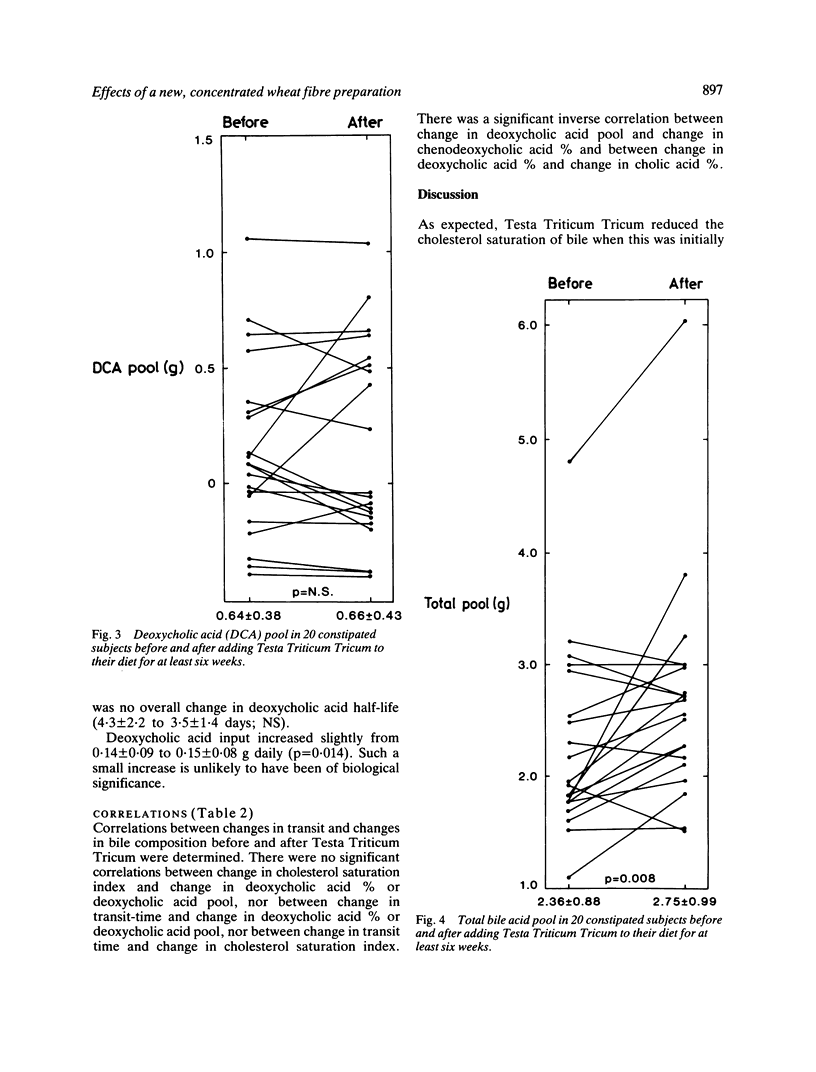
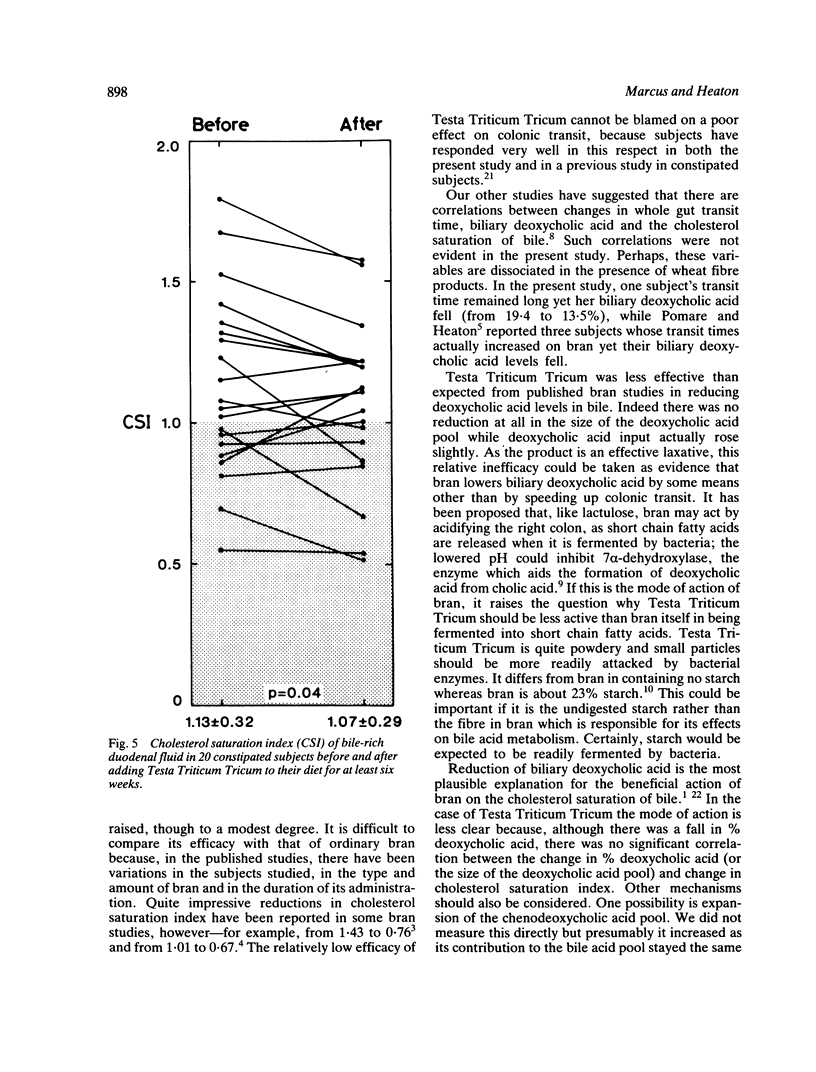
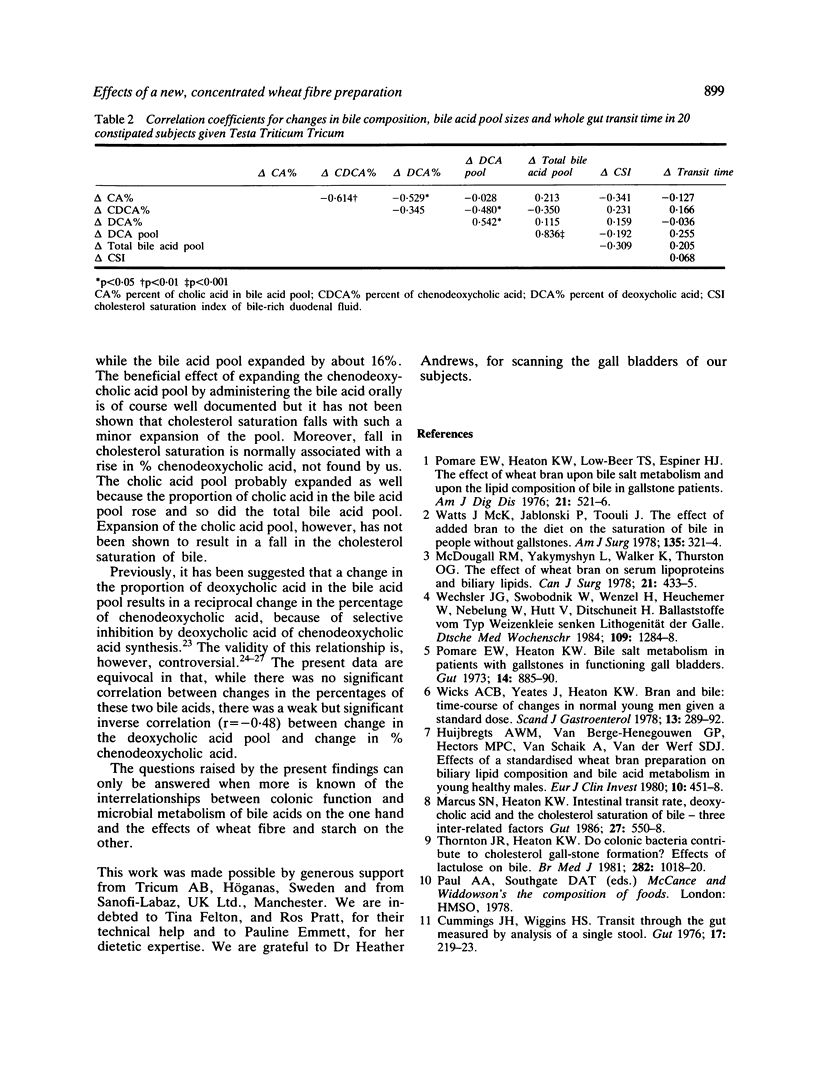
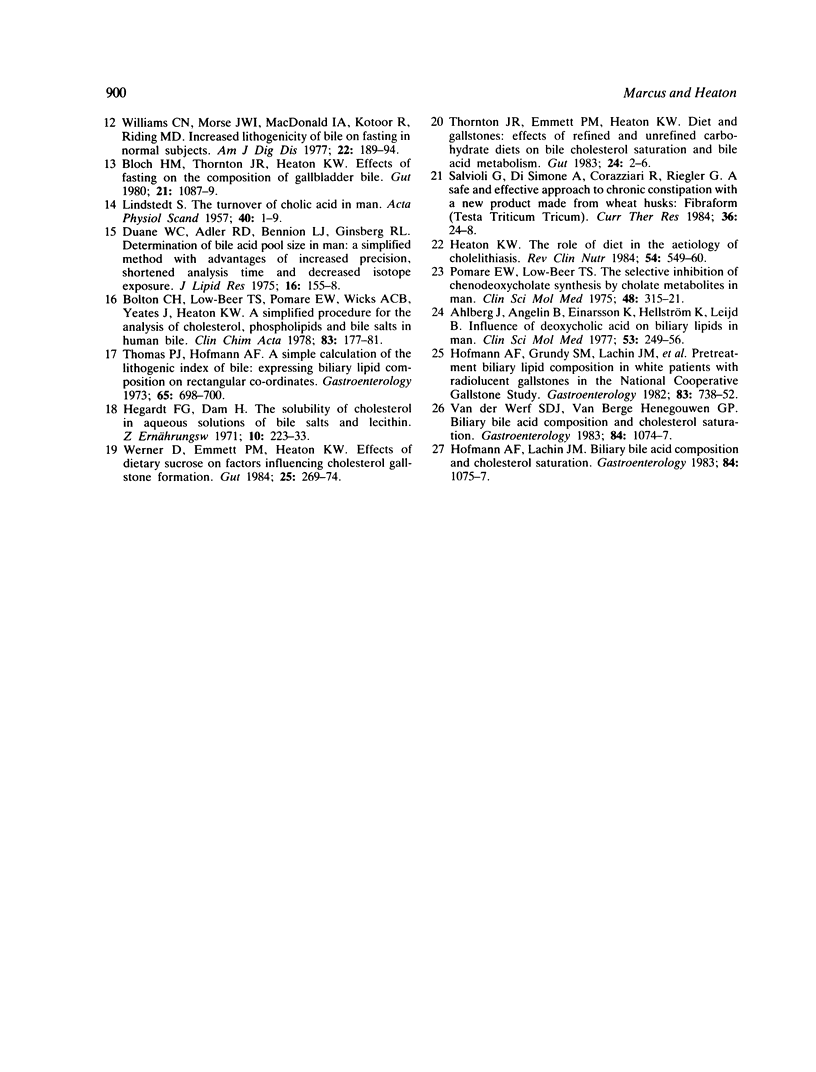
Selected References
These references are in PubMed. This may not be the complete list of references from this article.
- Ahlberg J., Angelin B., Einarsson K., Hellstrom K., Leijd B. Influence of deoxycholic acid on biliary lipids in man. Clin Sci Mol Med. 1977 Sep;53(3):249–256. doi: 10.1042/cs0530249. [DOI] [PubMed] [Google Scholar]
- Bloch H. M., Thornton J. R., Heaton K. W. Effects of fasting on the composition of gallbladder bile. Gut. 1980 Dec;21(12):1087–1089. doi: 10.1136/gut.21.12.1087. [DOI] [PMC free article] [PubMed] [Google Scholar]
- Bolton C. H., Low-Beer T. S., Pomare E. W., Wicks A. C., Yeates J., Heaton K. W. A simplified procedure for the analysis of cholesterol, phospholipids and bile salts in human bile. Clin Chim Acta. 1978 Feb 1;83(1-2):177–181. doi: 10.1016/0009-8981(78)90222-x. [DOI] [PubMed] [Google Scholar]
- Cummings J. H., Wiggins H. S. Transit through the gut measured by analysis of a single stool. Gut. 1976 Mar;17(3):219–223. doi: 10.1136/gut.17.3.219. [DOI] [PMC free article] [PubMed] [Google Scholar]
- Duane W. C., Adler R. D., Bennion L. J., Ginsberg R. L. Determination of bile acid pool size in man: a simplified method with advantages of increases precision, shortened analysis time, and decreased isotope exposure. J Lipid Res. 1975 Mar;16(2):155–158. [PubMed] [Google Scholar]
- Hegardt F. G., Dam H. The solubility of cholesterol in aqueous solutions of bile salts and lecithin. Z Ernahrungswiss. 1971 Apr;10(3):223–233. doi: 10.1007/BF02020933. [DOI] [PubMed] [Google Scholar]
- Hofmann A. F., Grundy S. M., Lachin J. M., Lan S. P., Baum R. A., Hanson R. F., Hersh T., Hightower N. C., Jr, Marks J. W., Mekhjian H. Pretreatment biliary lipid composition in white patients with radiolucent gallstones in the National Cooperative Gallstone Study. Gastroenterology. 1982 Oct;83(4):738–752. [PubMed] [Google Scholar]
- Huijbregts A. W., Van Berge-Henegouwen G. P., Hectors M. P., Van Schaik A., Van der Werf S. D. Effects of a standardized wheat bran preparation on biliary lipid composition and bile acid metabolism in young healthy males. Eur J Clin Invest. 1980 Dec;10(6):451–458. doi: 10.1111/j.1365-2362.1980.tb02084.x. [DOI] [PubMed] [Google Scholar]
- LINDSTEDT S. The turnover of cholic acid in man: bile acids and steroids. Acta Physiol Scand. 1957 Sep 17;40(1):1–9. doi: 10.1111/j.1748-1716.1957.tb01473.x. [DOI] [PubMed] [Google Scholar]
- Marcus S. N., Heaton K. W. Intestinal transit, deoxycholic acid and the cholesterol saturation of bile--three inter-related factors. Gut. 1986 May;27(5):550–558. doi: 10.1136/gut.27.5.550. [DOI] [PMC free article] [PubMed] [Google Scholar]
- McDougall R. M., Yakymyshyn L., Walker K., Thurston O. G. Effect of wheat bran on serum lipoproteins and biliary lipids. Can J Surg. 1978 Sep;21(5):433–435. [PubMed] [Google Scholar]
- Pomare E. W., Heaton K. W. Bile salt metabolism in patients with gallstones in functioning gallbladders. Gut. 1973 Nov;14(11):885–890. doi: 10.1136/gut.14.11.885. [DOI] [PMC free article] [PubMed] [Google Scholar]
- Pomare E. W., Heaton K. W., Low-Beer T. S., Espiner H. J. The effect of wheat bran upon bile salt metabolism and upon the lipid composition of bile in gallstone patients. Am J Dig Dis. 1976 Jul;21(7):521–526. doi: 10.1007/BF01464757. [DOI] [PubMed] [Google Scholar]
- Pomare E. W., Low-Beer T. S. The selective inhibition of chenodeoxycholate synthesis by cholate metabolites in man. Clin Sci Mol Med. 1975 Apr;48(4):315–321. doi: 10.1042/cs0480315. [DOI] [PubMed] [Google Scholar]
- Thomas P. J., Hofmann A. F. Letter: A simple calculation of the lithogenic index of bile: expressing biliary lipid composition on rectangular coordinates. Gastroenterology. 1973 Oct;65(4):698–700. [PubMed] [Google Scholar]
- Thornton J. R., Emmett P. M., Heaton K. W. Diet and gall stones: effects of refined and unrefined carbohydrate diets on bile cholesterol saturation and bile acid metabolism. Gut. 1983 Jan;24(1):2–6. doi: 10.1136/gut.24.1.2. [DOI] [PMC free article] [PubMed] [Google Scholar]
- Thornton J. R., Heaton K. W. Do colonic bacteria contribute to cholesterol gall-stone formation? Effects of lactulose on bile. Br Med J (Clin Res Ed) 1981 Mar 28;282(6269):1018–1020. doi: 10.1136/bmj.282.6269.1018. [DOI] [PMC free article] [PubMed] [Google Scholar]
- Watts J. M., Jablonski P., Toouli J. The effect of added bran to the diet on the saturation of bilein people without gallstones. Am J Surg. 1978 Mar;135(3):321–324. doi: 10.1016/0002-9610(78)90059-4. [DOI] [PubMed] [Google Scholar]
- Wechsler J. G., Swobodnik W., Wenzel H., Heuchemer T., Nebelung W., Hutt V., Ditschuneit H. Ballaststoffe vom Typ Weizenkleie senken Lithogenität der Galle. Dtsch Med Wochenschr. 1984 Aug 24;109(34):1284–1288. doi: 10.1055/s-2008-1069364. [DOI] [PubMed] [Google Scholar]
- Werner D., Emmett P. M., Heaton K. W. Effects of dietary sucrose on factors influencing cholesterol gall stone formation. Gut. 1984 Mar;25(3):269–274. doi: 10.1136/gut.25.3.269. [DOI] [PMC free article] [PubMed] [Google Scholar]
- Wicks A. C., Yeates J., Heaton K. W. Bran and bile: time-course of changes in normal young men given a standard dose. Scand J Gastroenterol. 1978;13(3):289–292. doi: 10.3109/00365527809179822. [DOI] [PubMed] [Google Scholar]
- Williams C. N., Morse J. W., MacDonald I. A., Kotoor R., Riding M. D. Increased lithogenicity of bile on fasting in normal subjects. Am J Dig Dis. 1977 Mar;22(3):189–194. doi: 10.1007/BF01072275. [DOI] [PubMed] [Google Scholar]
- van der Werf S. D., van Berge Henegouwen G. P. Biliary bile acid composition and cholesterol saturation. Gastroenterology. 1983 May;84(5 Pt 1):1074–1077. [PubMed] [Google Scholar]


